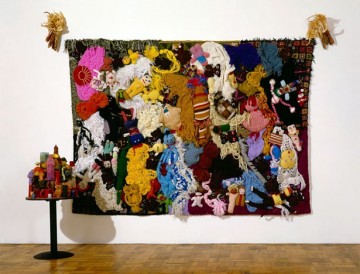
Originally published in the Marina Times San Francisco in March 2014
The largest exhibition of Mike Kelley’s work will take up the entire space that is the Geffen Contemporary at the Museum of Contemporary Art in Los Angeles, from March 31 to July 28, 2014. Kelley’s body of work isn’t easily categorized — he was a visual artist who utilized paint, sculpture, assemblage, fabric, music, the spoken word, film, photography — all with a counterculture twist that deconstructs assumptions of art and society.
Kelley was born in Detroit and moved to Los Angeles in 1976, where he became a de-fining influence in the contemporary art world. As an artist, teacher and collaborator, his work dug deep under the surface of culture and personal identity with a dark wit and defiance of tradition that defined his style, regardless of the medium.
Interaction with the peculiar sparks the viewer’s imagination. I’m reminded of a Mike Kelley exhibition I attended a few years ago. A group of museumgoers, myself included, stood around a roped-off area. Piled against the wall inside this area was a collection of soiled, torn plush toys (a Kelley theme), strewn on the floor around a cardboard box with an open lid. The stuffed animals looked abandoned. Dead. Forgotten.
“What’s inside?” I turned to look at a small, older man dressed in a smart three-piece suit. He was asking me the question. “I’m too short,” he said. “I can’t see inside the box. Can you see what’s inside?”
We both leaned in on our tiptoes, straining to see. “No, I can’t see anything,” I said. Maybe we aren’t supposed to see inside the box. Or maybe it’s just empty?”
“It could have more toys in it!” he answered. My new acquaintance then told enthusiastic stories of other Mike Kelley exhibitions, events and installations he’d witnessed through the years. Others stopped to listen. He compared what we were viewing to Kurt Schwitters’s Merzbau, and elaborated on the ways that abstract spaces can change what is visually possible.
His excitement turned into a moment of self-conscious apprehension. He became quiet, looked at his shoes. “I’m sorry. I’m getting so carried away. I’m talking far too much, and we are in a museum.” “No, it’s fantastic what you’ve said,” I replied. “Thank you.” We laughed, the moment of self-doubt now evaporated.
That’s my favorite Mike Kelley memory: Standing in a museum side-by-side with a stranger, our arms around each other, quietly giggling amongst Kelley’s obliterated toys.